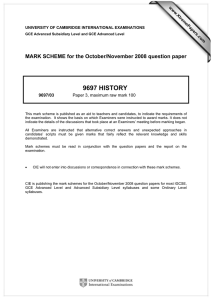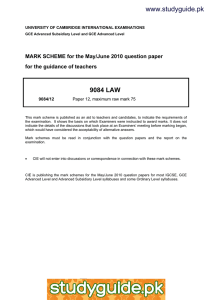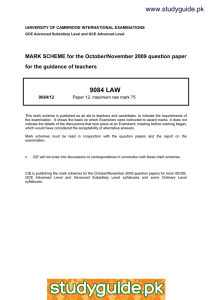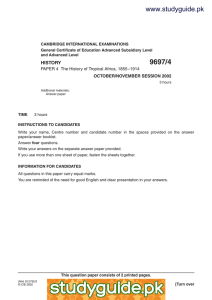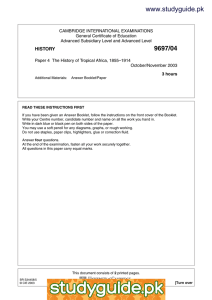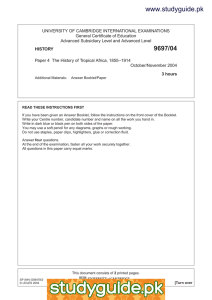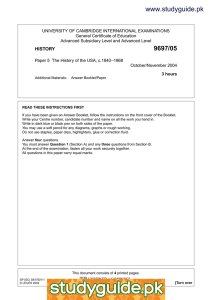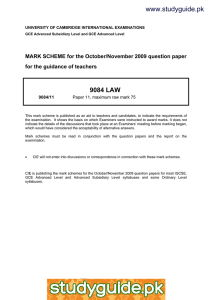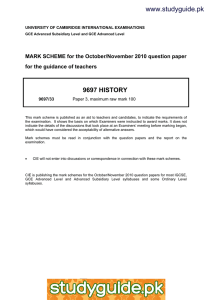www.studyguide.pk 9697 HISTORY
advertisement
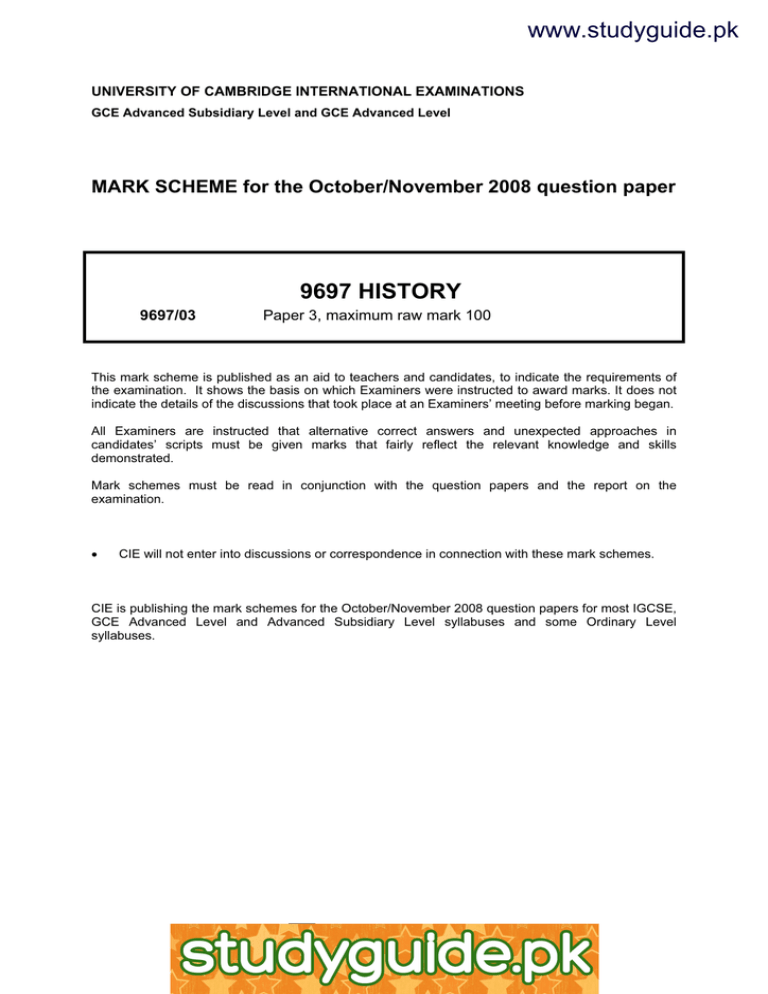
www.studyguide.pk UNIVERSITY OF CAMBRIDGE INTERNATIONAL EXAMINATIONS GCE Advanced Subsidiary Level and GCE Advanced Level MARK SCHEME for the October/November 2008 question paper 9697 HISTORY 9697/03 Paper 3, maximum raw mark 100 This mark scheme is published as an aid to teachers and candidates, to indicate the requirements of the examination. It shows the basis on which Examiners were instructed to award marks. It does not indicate the details of the discussions that took place at an Examiners’ meeting before marking began. All Examiners are instructed that alternative correct answers and unexpected approaches in candidates’ scripts must be given marks that fairly reflect the relevant knowledge and skills demonstrated. Mark schemes must be read in conjunction with the question papers and the report on the examination. • CIE will not enter into discussions or correspondence in connection with these mark schemes. CIE is publishing the mark schemes for the October/November 2008 question papers for most IGCSE, GCE Advanced Level and Advanced Subsidiary Level syllabuses and some Ordinary Level syllabuses. www.xtremepapers.net www.studyguide.pk Page 2 Mark Scheme GCE A/AS LEVEL – October/November 2008 Syllabus 9697 Paper 03 Generic mark bands for essay questions Examiners will assess which Level of Response best reflects most of the answer. An answer will not be required to demonstrate all of the descriptions in a particular Level to qualify for a Mark Band. Band Marks Levels of Response 1 21–25 2 18–20 3 16–17 4 14–15 5 11–13 6 8–10 7 0–7 The approach will be consistently analytical or explanatory rather than descriptive or narrative. Essays will be fully relevant. The argument will be structured coherently and supported by very appropriate factual material and ideas. The writing will be accurate. At the lower end of the band, there may be some weaker sections but the overall quality will show that the candidate is in control of the argument. The best answers must be awarded 25 marks. Essays will be focused clearly on the demands of the question but there will be some unevenness. The approach will be mostly analytical or explanatory rather than descriptive or narrative. The answer will be mostly relevant. Most of the argument will be structured coherently and supported by largely accurate factual material. The impression will be that that a good solid answer has been provided. Essays will reflect a clear understanding of the question and a fair attempt to provide an argument and factual knowledge to answer it. The approach will contain analysis or explanation but there may be some heavily descriptive or narrative passages. The answer will be largely relevant. Essays will achieve a genuine argument but may lack balance and depth in factual knowledge. Most of the answer will be structured satisfactorily but some parts may lack full coherence. Essays will indicate attempts to argue relevantly although often implicitly. The approach will depend more on some heavily descriptive or narrative passages than on analysis or explanation, which may be limited to introductions and conclusions. Factual material, sometimes very full, will be used to impart information or describe events rather than to address directly the requirements of the question. The structure of the argument could be more organised more effectively. Essays will offer some appropriate elements but there will be little attempt generally to link factual material to the requirements of the question. The approach will lack analysis and the quality of the description or narrative, although sufficiently accurate and relevant to the topic if not the particular question, will not be linked effectively to the argument. The structure will show weaknesses and the treatment of topics within the answer will be unbalanced. Essays will not be properly focused on the requirements of the question. There may be many unsupported assertions and commentaries that lack sufficient factual support. The argument may be of limited relevance to the topic and there may be confusion about the implications of the question. Essays will be characterised by significant irrelevance or arguments that do not begin to make significant points. The answers may be largely fragmentary and incoherent. Marks at the bottom of this Band will be given very rarely because even the most wayward and fragmentary answers usually make at least a few valid points. © UCLES 2008 www.xtremepapers.net www.studyguide.pk Page 3 Mark Scheme GCE A/AS LEVEL – October/November 2008 Syllabus 9697 Paper 03 Note: all papers are to be marked using the generic marking bands for source-based and essay questions. Section A: The UN Secretary-General and the Congo Crisis 1 Source-based question: How far do Sources A-E support the view that Dag Hammarskjold’s involvement in the Congo Crisis had positive results? Content Contemporary view of the UNO; A UN Security Council Resolution. Contemporary TV broadcast from Britain. Analysis L2–3 Highlights view that UN response was both effective and appropriate. Highlights USSR complaint against Hammarskjold. N X ref with D and E Views limited mainly to non UNO sources. C Contemporary UN SecretaryGeneral Speech. Y X Ref with A. View of one person. D Secondary view by an American historian almost 30 years after the event. Secondary view from major UNO source. Takes view that SecretaryGeneral highlights major turning point in UNO history. View that UN outsmarted by US acts, in particular by CIA. N X ref with B and E. Sees UNO acting too slowly and without experience. Criticises UN role and states that UNO was largely irrelevant to the outcome. X ref with B and D. All non-UNO sources. Claims UNO put in very difficult position with breakdown in relations within Security Council. A B E Highlights major difficulties faced by Sec-Gen Hammarskjold. Y Y/N EVALUATION X Ref with C. © UCLES 2008 www.xtremepapers.net L4–5 Source states the intention of the UNO not the outcome of its intervention. Showed willing but needs to be corroborated. Takes a balanced view stating that USSR view countered by UK support for S-G. Takes positive stand but Secretary-General likely to defend his own actions. Y/ N Y/N Y/N N Y/N www.studyguide.pk Page 4 Mark Scheme GCE A/AS LEVEL – October/November 2008 Syllabus 9697 L1 WRITES ABOUT THE HYPOTHESIS, NO VALID USE OF SOURCES Paper 03 [1–5] These answers will write about the UN Secretary-General and/or the Congo Crisis and might use the sources. However, candidates will not use the sources as information/evidence to test the given hypothesis. If sources are used, it will be to support an essay-style answer to the question. L2 USES INFORMATION TAKEN FROM THE SOURCES TO CHALLENGE OR SUPPORT THE HYPOTHESIS [6–8] These answers use the sources as information rather than as evidence, i.e. sources are used at face value only with no evaluation/interpretation in context, e.g. EITHER I think Dag Hammarskjold was central to the attempt to find a solution. This is supported by Source A which is a Security Council Resolution which praises him. Also Source C gives him considerable credit regarding his actions as a turning point in the history of the UNO. Also, in part, Source E claims him to be a sort of diplomatic superman. OR I think Hammarskjold was not central. Source B criticises him. The Soviet Premier was so upset he wanted the post of Secretary-General replaced by a triumvirate. Also, Source D suggests that the UN, and Hammarskjold were ignored and the problem was ultimately solved by the USA’s intervention to become the dominant foreign power in the Congo by 1965. Also Source E suggests he upset the French and Soviets and left big problems for his successor to sort out. L3 USES INFORMATION TAKEN FROM SOURCES TO CHALLENGE AND SUPPORT THE HYPOTHESIS [9–13] These answers know that testing the hypothesis involves both attempting to confirm and to disprove it. However, sources are still used only at face value, e.g. Sources A and C clearly confirm the view that Hammarskjold’s involvement was central to finding a solution to the Congo Crisis. This is supported by Source E which regards him as a sort of superman. However, Source B suggests that the USSR did not rate him highly. Source D tends to support that view because it states the US played a central role, while Source E suggests that he fell out badly with both France and the USSR making it difficult to find a solution. L4 BY INTERPRETING/EVALUATING SOURCES IN CONTEXT, FINDS EVIDENCE TO CHALLENGE OR SUPPORT THE HYPOTHESIS [14–16] These answers are capable of using sources as evidence, i.e. demonstrating their utility in testing the hypothesis, by interpreting them in their historical context, i.e. not simply accepting them at their face value, e.g. EITHER The Secretary-General did not play a central role because an American historian writing years after the event felt the US played a more important role. This is supported by Source E, written by a former Under Secretary-General who would have the knowledge and expertise to assess Hammarskjold’s role. Or, alternatively, Source C, would almost invariably praise him as it was at the Peace Prize ceremony and Hammarskjold had died only shortly before. © UCLES 2008 www.xtremepapers.net www.studyguide.pk Page 5 Mark Scheme GCE A/AS LEVEL – October/November 2008 Syllabus 9697 Paper 03 OR As Source A is from the UN itself and was produced at the time this shows clearly that he played a central role. Also, the acceptance speech for the Nobel Peace Prize would try to offer a general view of his achievements. Finally, Source B, by the BBC would almost invariably praise a British Prime Minister but castigate the Soviet leader as it was at the height of the Cold War. L5 BY INTERPRETING/EVALUATING SOURCES IN CONTEXT, FINDS EVIDENCE TO CHALLENGE AND SUPPORT THE HYPOTHESIS [17–21] These answers know that testing the hypothesis involves attempting both to confirm and disconfirm the hypothesis, and are capable of using sources as evidence to do this (i.e. both confirmation and disconfirmation are done at this level). L6 AS L5, PLUS EITHER (a) EXPLAINS WHY EVIDENCE TO CHALLENGE/SUPPORT IS BETTER/PREFERRED, OR (b) RECONCILES/EXPLAINS PROBLEMS IN THE EVIDENCE TO SHOW THAT NEITHER CHALLENGE NOR SUPPORT IS TO BE PREFERRED [22–25] For (a) the argument must be that the evidence for agreeing/disagreeing is better/preferred. This must involve a comparative judgement, i.e. not just why some evidence is better, but also why other evidence is worse. For (b) include all L5 answers which use the evidence to modify the hypothesis (rather than simply seeking to support/contradict) in order to improve it. For example, I accept the views of Source D because it is written by an historian many years after the event. This is more accurate than the views expressed in Sources B and C which could be biased. Also Source E is to be regarded highly as it is written by a former senior UN diplomat. However, contextual knowledge shows that (i) In the crisis Hammarskjold helped remove Belgian troops without too much bloodshed. He had helped establish a black government in Leopoldville and was preventing the separation of the province of Katanga. (ii) The UNO ultimately, played a minor role as the Congo became an episode in the Cold war with the USSR supporting Lumumba and the USA Mobutu. It was the result of US aid and intervention that Mobutu won the civil war and re-imposed peace in the Congo. © UCLES 2008 www.xtremepapers.net www.studyguide.pk Page 6 Mark Scheme GCE A/AS LEVEL – October/November 2008 Syllabus 9697 Paper 03 Section B 2 How far was the Cold War, in the period 1945 to 1949, caused by Soviet expansionism in Eastern Europe? This question will allow candidates to consider the historical debate on the origins of the Cold War in Europe. Part of the traditional interpretation of the debate has regarded Stalin’s takeover of Eastern Europe as an example of Soviet imperialism. This can be countered by references to both the revisionist and post-revisionist interpretations. They may argue that Soviet expansionism in Eastern Europe was purely defensive. A more important factor was the development of the US policy of containment. Alternatively, they can consider the post-revisionist view which places blame on both the superpowers. 3 ‘The Cold War, in the period 1950 to 1979, showed that the USA’s fear of communist world domination was irrational.’ How far do you agree? This question offers candidates the opportunity to study the Cold War in a thematic way. It will allow them the opportunity to consider the factors underlying the globalisation of the Cold War. One such factor was the US fear of a global communist conspiracy which was dominated by the USSR and Communist China. The belief that the Soviet Union and China worked together persisted after the Sino-Soviet split had developed. It was only with the advent of détente that the divisions between the USSR and China were accepted by the USA. Also candidates can mention the policies of containment and roll back as part of the US belief in a global communist threat. In more specific terms, candidates could mention the domino theory as put forward initially by Eisenhower. Although it applied to South East Asia it can be cited as an example of US fears of communism. To counter this view, candidates could mention the development of Soviet influence outside Eastern Europe as a factor in the development of the Cold War. The Cuban Missile Crisis of 1962 and the sponsorship of liberation struggles in Africa and Asia can be cited as examples. 4 How far was the direct US military intervention in Vietnam due to President Lyndon Johnson? This question offers candidates the opportunity to study part of the Cold War as a specific subject. In response to the question candidates can mention the Gulf of Tonkin Incident and Resolution of 1964 and the decision to commit combat troops to South Vietnam in March 1965. In addition, candidates may mention the large troop deployment from 1965 to 1968 which saw US troop levels reach 565 000. In many ways the US war in Vietnam was Johnson’s War. However, candidates can offer counter-arguments. The Eisenhower administration’s decision to offer military aid to the Diem regime can be regarded as the beginning of the process. An important area of debate surrounds JFK. His decision to increase the number of military advisers, his covert operations in Laos and the assassination of Diem in November 1963 all placed Johnson in a very difficult position. Either he could withdraw and leave South Vietnam to communism or increase military support. © UCLES 2008 www.xtremepapers.net www.studyguide.pk Page 7 5 Mark Scheme GCE A/AS LEVEL – October/November 2008 Syllabus 9697 Paper 03 Who, or what, was responsible for the Sino-Soviet conflict? This question offers candidates the opportunity to assess the development of the Sino-Soviet split. They can state that Mao’s desire to be the world leader of communism, following the death of Stalin, was almost bound to lead to rivalry. Also Mao developed an alternative version of communism based on peasant, agricultural communism which offered a rival to the MarxistLeninist interpretation of communism within the USSR. This enabled Mao to dispense with Soviet industrial experts in the late 1950s, enabling China to engage in the ‘Great Leap Forward’, with disastrous consequences. Also, the Cultural Revolution heightened tension between the USSR and China, leading eventually to the Ussuri River Incident. A counter argument may suggest that following the denunciation of Stalin in 1956 the two communist superpowers began to diverge. Also, the Sino-Soviet split could be seen as inevitable when two large powers began to challenge for the leadership of the world communist movement. 6 Assess the impact of the nuclear arms race on the development of the Cold War from 1949 to 1989. This question offers candidates the opportunity to assess the role of nuclear weapons in the development of the Cold war. The nuclear arms race led to the development of massive retaliation, MAD (mutually assured destruction) and flexible response. It also prevented the two superpowers from direct military confrontation, except for Cuba in October 1962. It also forced the two superpowers to develop ways of limiting the possibility of a nuclear war: the Nuclear Proliferation Treaty of 1968; SALT, START and the ABM treaty. Other factors include the development of proxy wars in areas such as Vietnam, Angola and the Horn of Africa. This also led to the development of naval and air bases across the globe by both superpowers, leading to superpower involvement in Africa and Asia. 7 ‘The most important factor in the growth of the international economy, from 1945 to 1980, was the continual movement towards free trade.’ How far do you agree? This question will afford the opportunity to assess the importance of free trade in the international economy from 1945. The GATT and the WTO can be used as evidence to suggest that a general liberalisation of trade arrangements from 1945 onwards greatly assisted the development of the international economy. As examples of regional agreements on free trade, candidates may cite the EU or NAFTA (this appears at the end of the period). However, candidates may adopt a different view. The Japanese economic miracle depended heavily on protection of the home market. Also, the EU can be regarded as a protectionist block against the rest of the world. Candidates may also cite other factors such as technological development as a more important factor. © UCLES 2008 www.xtremepapers.net www.studyguide.pk Page 8 8 Mark Scheme GCE A/AS LEVEL – October/November 2008 Syllabus 9697 Paper 03 To what extent have the problems facing Third World countries, in the period 1973 to 1991, been the result of the oil crises of 1973 and 1979? This question offers candidates the chance to assess the importance of the two oil crises in causing the economic problems of the Third World. The quadrupling of the world price of oil in 1973 and its doubling in 1979 placed the international economy into a period of recession. Third World countries found it increasingly difficult to sell their goods abroad. Also the debts incurred as a result virtually crippled many economies in Latin America and Africa. To counter the argument candidates may mention natural disasters such as famine in the Horn of Africa; warfare (which afflicted much of sub-Saharan Africa); corrupt governments and exploitation by more successful ‘First World’ economies. © UCLES 2008 www.xtremepapers.net
